The Municipal Metro of Yokohama is an underground public transport system situated in the urban area of Yokohama, in the Kanagawa prefecture, in Japan. This city has a medium-sized metro, as it is relatively small compared to other systems in the country. It has a total length of 53.4 km divided between two operative lines that serve a total of 42 stations. The first phase was inaugurated in 1972, and today is an integral part of the city’s transport infrastructure, with many connections to other transport systems, especially with the modern suburban train networks that cover most of the Japanese territory.
The Metro is operated by an institution that is controlled by the local government. The regional and suburban train networks are operated by private companies, however. The basic tariff is ¥210 JPY (about $1.84 USD) for a short trip (less than 3 km). The system is open from approximately 5:20 a.m. to 12:30 at night.
Metros in Japan: Yokohama
The city
The city of Yokohama is the second largest city in the country, as only Tokyo is larger. There are about 3.7 million people living within its borders. The city is located on Tokyo Bay, south of Tokyo, in the Kantō region of the main Japanese island of Honshu. It is the capital city of the Kanagawa prefecture. The city has a total surface area of 437.38 square km, and lies right off the coast of the Pacific Ocean, on the Tokyo Bay area.
Yokohama is notable for its port. It has served the city since 1859 and is now the most important port in the country. Because of this, Yokohama has developed large industrial centers. Even after the destruction brought by air bombings during World War II, and especially because Japan opened to the world shortly after, the city became an important economic center.
This is easily seen in its well-known Minato Mirai 21 (Future Port 21) district. Even though the western world has heavily influenced Yokohama, it is interesting to see the contrast between modern high-rise buildings, public infrastructure, parks and sporting venues and the traditional Japanese architecture.
The climate around the area is humid subtropical, with hot summers and chilly winters. The temperature averages from 6 to 8 °C during winters and from 15 to 24 °C during summers.
The metro
The municipal subway system of Yokohama is one of the main transport systems in the city. It serves a total of 42 stations distributed along a 53.4 km-long network. The trains are comprised of 6 wagons on the Blue Line, but only 4 in the Green Line.
The rolling stock come from different manufacturers. The trains that serve the Blue Line were built by the Japan Transport Engineering Company, previously known as Tokyo Car Corporation. Several types of cars from the 3000 series operate on this line. On the Green Line, the only model of train currently in service is the 1000 series, built by Kawasaki Heavy Industries Rolling Stock Company.
Because the Green Line only has 4 wagons on each train, carrying capacity is rather low. Studies are already being carried out to check the feasibility of increasing the number of wagons in each train. In 2014, the average daily ridership of the Yokohama metro was of 643,000 people. The operating company is the Yokohama City Transportation Bureau, an entity dependent on the local government. This company also regulates all bus lines in the city.
- Known as: Metro
- System length: 53.4 km
- Track gauge: 1435 mm
- Number of lines: 2
- Number of stations: 42
- Maximum operating speed: 80 km/h
- Website: www.city.yokohama.lg.jp/koutuu/sub
- Operated by: Yokohama City Transportation Bureau
- Daily ridership: about 643,000 people in 2014
- Inaugurated: December 16th, 1972
Brief history
As with any other large city, Yokohama was in need of a better, more efficient solution for its transport needs that the traditional bus lines.
By the year 1965, a layout of the subway was already developed, and it included three subway lines. Construction began according to that plan, but the final metro lines were slightly modified from their original routes.
A few years later, in 1972, the Yokohama Municipality Subway was officially inaugurated. The first phase served 6 stations along the Blue Line, and ran between Isezaki-chōjamachi and Kamiōoka stations. This line has received many modifications and expansions since then. In 1976, it was extended to Kaminagaya Station and to Yokohama Central station. It was also expanded in 1985, 1987, 1989, 1993 and finally in 1999, completing the 32 stations that are open today.
The Green Line is far more recent, although it was planned almost at the same time as the Blue Line. It was in the year 2001 that construction works initiated, and they were completed in 2008. It serves a total of 10 stations, but large extension plans are already on the way from both ends of this line.
Lines and stations
There are only two lines on the Yokohama Municipal Metro: the Blue Line and the Green Line. Most of the stations in the system are subterranean, but some of them (6 in total) are superficial. Three of those are in the Blue Line, one in the Green Line and two that are shared between the lines.
It is important to note that in Japanese transport systems, most routes are identified by a number, and they may or may not coincide with the real routes. This is the case of the Yokohama Metro, as there are three routes identified by numbers, regardless of the two lines that are identified by colors.
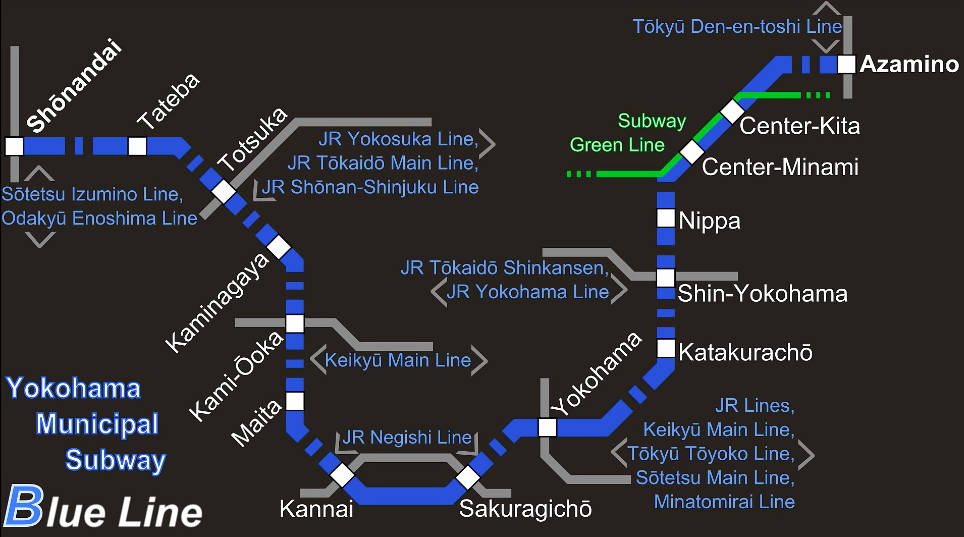
Blue Line
This was the first line of the system. It was inaugurated on December 16th, 1972. At its first stage, this line was 5.2 km in length and had 6 stations. After six expansions, the most recent of them finished in 1999, this line has a total length of 40.4 km and serves 32 stations.
Most of the stations on this line are located underground, except for Kaminagaya station and a small extension that comprises Nippa, Nakamachidai, Minami Center and Kita Center stations. Apart from those, all stations are subterranean. This is the longest line on the metro. It passes through many districts of the city, including: Aoba-ku, Tsuzuki-ku, Kōhoku-ku, Kanagawa-ku, Nishi-ku, Naka-ku, Minami-ku, Kōnan-ku, Totsuka-ku, and Izumi-ku districts in Yokohama, and Fujisawa district in Kanagawa.
The Blue Line is divided internally into two separate lines identified by numbers: line 1 and 3. Line 1 has an extension of 19.7 km and serves 17 stations along them. Its terminal stations are Shōnandai and Kannai. The rest of the Blue Line is covered by line 3, which has an extension of 20.7 km and serves 26 stations. One of its terminals is Kannai, while the other is Azamino. Thus, the terminals for the entire Blue Line are Shōnandai and Azamino stations.
The Blue Line is very well-connected with other forms of public transport, especially suburban, regional and long-range trains. Transfer to and from the Green Line occurs at two shared stations: Kita Center and Minami Center. In the year 2014, an average of 513,897 people rode this line every day. This metro line is identified in the regional system by its color (Blue) and by the letter B, the first letter of that word.
Green Line
This was the second line in the Metro of Yokohama. It was officially opened to the public in March 30th, 2008. It has a total of 10 stations distributed along 13.1 km of length. Since its construction, it has not received any extensions. Its only superficial stations are Kawawachō and the stations it shares with the Blue Line (Kita Center and Minami Center). The rest are completely underground. The districts served by this line are:Midori-ku, Tsuzuki-ku and Kōhoku-ku.
According to the numerical identification of the system, the Green Line is also known as line 4 of the Yokohama Municipal Metro. Its terminals are Nakayama and Hiyoshi. This line is identified in the local area by the color green and by the letter G, the first letter of that word. An average of 129,104 people travelled in this line in 2014.
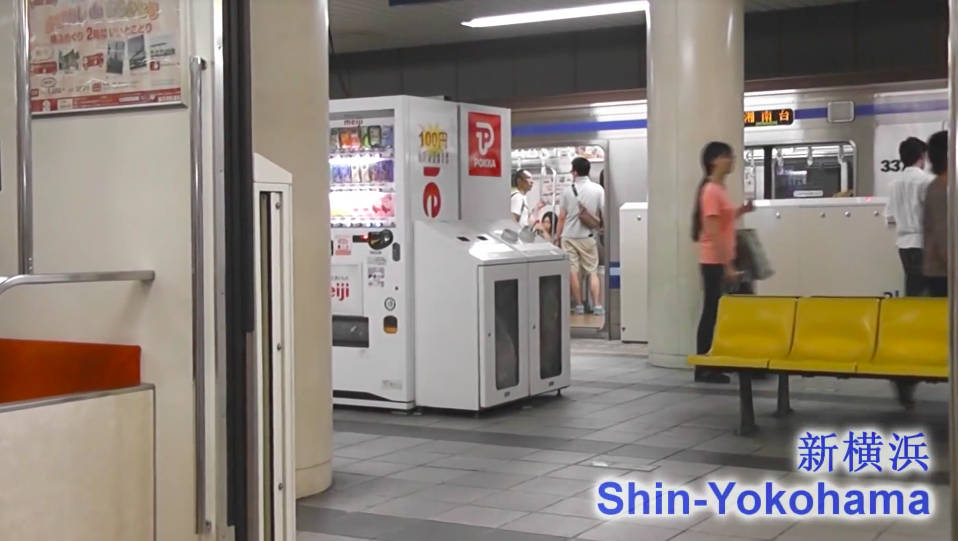
Connections with other systems
In Japan, terrestrial transport systems are vital. Apart from the city metro systems, generally run by public institutions or organizations that respond to the local governments, there are many private companies that operate train lines, be it suburban, regional or long-distance. This is very true for Yokohama as it is part of the Greater Tokyo Area, a large, very densely populated zone around the Tokyo Bay. Millions of people have a daily need for public transport.
This demand is served by many different transport companies that operate several public transport systems. One of the most important of these is the Japan Railway Company East (JR East). Shin-Yokohama station of the Blue line and Nakayama station of the Green line are connected to the Yokohama line from this company. Railway lines Tokaido and Yokosuka are connected to the metro via Yokohama and Totsuka stations. The Negishi railway line is linked to the system through Yokohama, Sakuragichō and Kannai stations. Keihin-Tohoku railway line is also connected via Yokohama station, while the Shonan-Shinjuku railway line passes through Totsuka station.
Another important service is provided by the railway lines that belong to the Tokyu Corporation. The first of these is the Tōkyū Tōyoko line, served by Yokohama and Hiyoshi stations. The Den-en-toshi railway line passes through Azamino station, while the Meguro line is linked to the metro via Hiyoshi station. Other railway operators include Keikyū (runs its Main line, passes through Yokohama and Kamiōoka stations), Minatomirai (runs a line with the same name through many places in the city), Odaiku (operates the Odaiku Enoshima line that connects to Shōnandai station) and Sagami (that runs its Main Line and the Izumino line, the latter of which is linked through Shōnandai station).
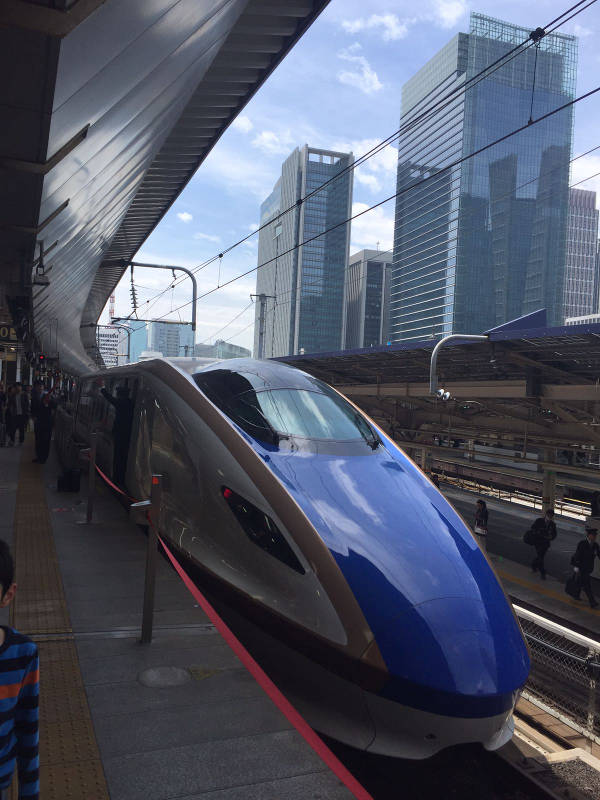
Another very important connection the metro has is the transfer to the Tōkaidō Shinkansen, a train better known around the globe with the name “Bullet Train”. It connects Tokyo and Osaka and was the train with the fastest operative speed in the world for many years. This high-speed train is connected to the metro via the Shin-Yokohama station. Working alongside the trains, there are over 50 bus lines that provide service to the entire city. They are run by the same parent company that operates the metro. The two are integrated and tickets can be valid for both systems.
Finally, there is also a connection with an aquatic bus (small ferry) that parts from the Yokohama Port. To reach it, passengers much use the eastern exit at Yokohama station. This line serves 4 stations, up to Yamashita Park.
Connections to the airports
The city of Yokohama has no airport of its own because it is part of the Greater Tokyo Metropolitan Area. Due to this, the city is mainly served by the two large international airports in the area: Narita and Haneda.
The Tokyo International Airport (commonly known as Haneda) is located on an artificial island on the Tokyo Bay, and is the closest one to the city of Yokohama (about 15 km). This airport has a long history, and handles most of the domestic flights to the city, although it does receive international flights as well. There is no direct connection from the metro, but the railway operator Keikyū offers a train that departs from Yokohama Central Station towards the airport, and connects with the Blue line.
The other airport is the Narita International Airport. This facility handles about 50% of all the international flights in the country. While Tokyo Narita (as it is commonly known) is much further from Yokohama than Haneda (almost 80 km on a straight line), it still receives most of the international passengers, so there are many transports to and from the airport. The easiest way to reach Yokohama from Narita or vice versa is through the Narita Express, a train that connects it with Tokyo, Shinjuku, Omiya and Yokohama. In the latter, the metro is linked with the railway in Yokohama and Totsuka stations.
Schedule and timetables
The schedule and frequency of the trains has been clearly established by the metro authorities. The information is available on the official website. Generally, the system opens before 5:30 a.m. and closes past midnight. The specific opening and closing hours, as well as the frequency of the trains vary between the lines.
In the Blue Line, the first train leaves the terminal (Azamino station) at 5:14 in the morning, while the last train leaves at 12:49 at night the next day. On weekends, the last train parts slightly earlier, at 12:19 at night.
For the Green Line, the first train leaves Hiyoshi station at 5:15 a.m. Monday through Friday, while the last train does the same at 12:40 at night. This changes a bit during weekends, as the first train leaves at 5:14 a.m., and the last train parts at 12:28 at night.
Regarding frequency or the service, this varies a lot during the day. The trains at the Blue Line run every 9 minutes at the start of a normal week day for the first hour, but at 6 a.m. the frequency increases and there is a train every 6 to 8 minutes. At 7 a.m., rush hour begins, and the trains speed up to match demand: the frequency is set at 4 minutes until 9 a.m. From this hour until 4:00 p.m., there is a train every 7 minutes. At 4:00 p.m., the frequency increases once more to one train every 5 or 6 minutes, and stays like so until about 11:00 p.m., when things start to slow down. The last trains to run do so every 12 minutes.
The Green Line experiences pretty much the same thing. From the time the system opens, trains run every 10 minutes, but the frequency increases to 6 and then to 4 minutes as the morning rush hour commences at about 7:00 a.m. The trains slow down a bit after 8:00 a.m. and the frequency is relatively stable until 11:00 p.m., when things really slow down, as trains pass every 12 minutes until the doors close for the night.
Tariffs, tickets and cards
There are several types of tickets that a passenger can use in the Yokohama Municipal Metro. The normal basic tariff is calculated based on the distance the passenger will travel, and starts at ¥210 JPY (about $1.84 USD) for tickets paid in cash. As with any other large public transport system, there are special pricing options for different kinds of users. All normal fares have a 50% discount for children.
The first offer are daily passes. This ticket allows the user to travel for as much as they desire, regardless of the distance, for an entire operative day (until the system closes). This ticket is priced at ¥740 ($6.48 USD).
There are also integrated daily passes that allow the users unlimited access to both the metro and the bus lines. This ticket has a normal cost of ¥830 ($7.27 USD).
Another option are the multiple tickets. These allow for up to 11 travels during peak hours, 12 uses from 10:00 a.m. to 4:00 p.m. (off-peak) and up to 14 uses during weekends and holidays.
There is a special card designed for frequent users of the Yokohama Metro called PASMO. Apart from the benefit of not using paper tickets, all passengers that acquire this card receive a slight discount on all tickets purchased.
Group tickets are also available and may be purchased at any station, a great option if you are travelling with friends or family.
Lastly, there are specialized monthly passes for frequent commuters and students that offer the best rates, but are tailored to those specific users that rely heavily on the public transport system. The pricing for ordinary tickets, depending on the distance travelled is as shown:
On the other hand, some tariffs for group tickets and monthly passes are as follow:
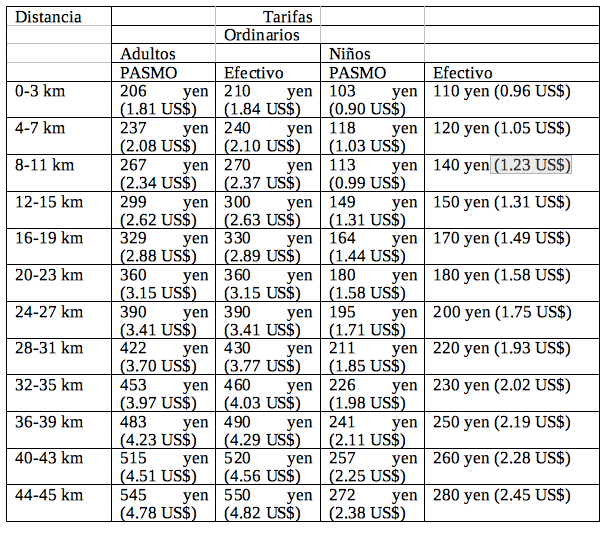
Tariffs for multiple tickets and cards.
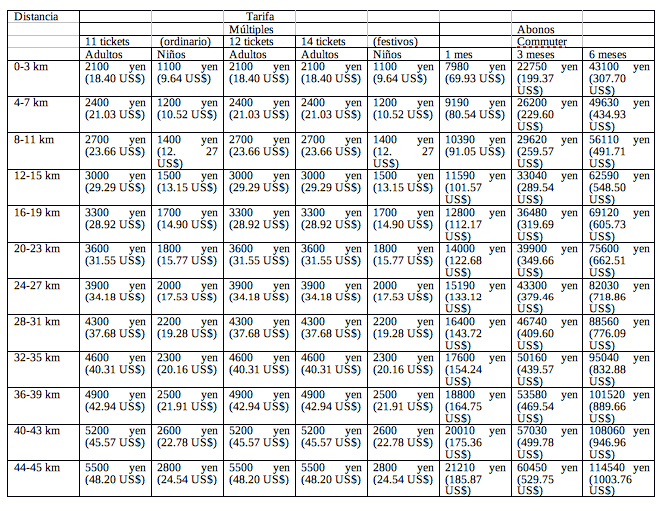
Future expansions
The Yokohama Municipal Metro is a robust public transport system that has a great future. As of today, there are many expansions being planned. Some of them have been put on hold, but most of the projects are being considered. One project for expansion involves connecting the Yokohama Metro with the soon-to-be-constructed Kawasaki Metro (a near-by city between Tokyo and Yokohama). One of the projects that will likely be set into motion soon will be the construction of Line 2, connecting Kanagawa-Shimachi to Byobugaura via Yokohama station, but local authorities have put it on hold.
Regarding plans on the existing lines, there is a planned extension on the Blue Line that would take it from the current terminal Azamino, towards Shin-Yurigaoka. The Green Line was originally conceived as a circular line, so most plans for the expansion of this line are focusing on completing that vision.
Advice
As with any other public transport system, there are a number of things that any user should be aware of before travelling on the Yokohama Municipal Metro.
- Follow all instructions that the system operators give you. If you are not able to understand Japanese, please ask for assistance or follow signs on English.
- Bicycles are not allowed in the metro except when properly packaged in special bags. They must not exceed certain maximum dimensions (250 cm in length). This same limit applies to any item passengers may carry with them.
- Plan your trip beforehand and buy your tickets calmly, as mistakes may occur due to the tariffs being calculated according to the distance travelled.
- There are specially marked seats for pregnant women, the elderly and the disabled. These must be left unoccupied by normal people. There is also an exclusive wagon for women, should they wish to travel on it.
Fun facts
- The general design of the stations involves white tiles on the walls, with blue and yellow decorations. This is true for the entire system.
- There is a special wagon on the Blue Line that may only be ridden by women.
- The Yokohama Metro is one of only nine metro systems in Japan.
Tourism and sightseeing
The city of Yokohama is large, multifaceted and cosmopolitan city that has established itself as a major commercial, industrial and financial hub within the Japanese archipelago, promoting its advantages to the Asian continent and the entire world. As a result of this, millions of tourists visit the city every year, walking its streets and embracing everything it has to offer. Some of the best places in Yokohama that can be easily reached via its metro system are:
- Minato Mirai 21: passengers must get off the trains at Sakuragicho station and walk a few blocks towards the sea to reach district Minato Mirai 21. This iconic area has become a prime commercial zone, as it has been developed with heavy tourism in mind. This port area is also home to many docks that serve the cruise ships that arrive or depart Yokohama.
- HARA Model Railway Museum: this is a must-see for all train lovers and a very compelling attraction altogether. Passengers must exit the subway at Takashimacho station and walk a few blocks to reach this magnificent museum, which has a very large collection of model trains that all the family will surely enjoy.
- Hongaku-ji Temple: Japan is a rich country with a very unique and deep culture, traditions and history. Special sites like this can be seen on multiple parts of the country. To reach the temple, passengers must get off the metro at Kanagawa station and walk a bit. It is a building of traditional Japanese architecture, and dates back to the 16th century.
Metro map of Yokohama
Map via www.city.yokohama.lg.jpSee map full resolution. It may take a little bit to load.
Yokohama Yokohama Municipal Subway map
- Also Known As: Yokohama Municipal Subway
- Passengers/Day 542000
- Fares:
- 24h operation: No
- Air Conditioning: No
- Walk between platforms: Yes
- Driverless trains: Kanazawa Seaside line, LRT, rubber-tyred (since 1989)
- Screen Doors Platforms: Kanazawa Seaside LRT line
- Operator: Yokohama City Transportation Bureau
- 206-545 Yen
- Yokohama Metro Official Website
Help us
If you consider that the information we provide is wrong, not accurated, outdated, translation contains errors, and you would like to help us to improve the file...you can contact us here.
Feel free to contact us if you dont find the system you're looking for and we'll add it as soon as we can!
Thank you very much!







